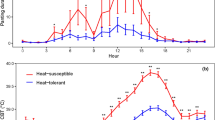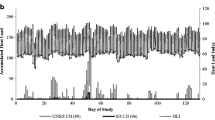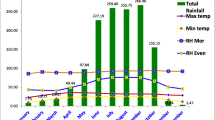Abstract
Heat stress in feedlot cattle causes reduced performance, and in the most severe cases, death of the animals, thus causing the loss of millions of dollars in revenue to the cattle industry. A study was designed to evaluate dynamics of thermoregulation and feeding activities when feeder cattle were exposed to simulated heat waves, in comparison with repeated sinusoidal hot and thermoneutral environments. Nine beef steers were randomly assigned to an individual pen in one of three environmental chambers. Each chamber was subjected to each of three temperature regimes (Heatwave simulation from Rockport, Mo., 1995, Heatwave simulation from Columbia, Mo., 1999, and Controlled heat stress treatment of 32±7°C) for a period of 18 days, according to a Latin square treatment design, with a 10-day thermoneutral period (18±7°C) separating treatment periods. Respiration rate, core body temperature, heat production, feed intake, and feeding behavior were measured on each animal for the duration of the experiment. Differences were found in all treatments for all parameters except feeding behavior. It was shown that the two simulated heat waves elicited very different thermoregulatory responses. Based on these results the heat wave centered at Rockport, Mo. in 1995 was devastating because the animals were not acclimated to hot conditions, thus causing an acute response to heat stress. The responses of cattle to conditions at Columbia, Mo. showed some acclimation to heat prior to the peak stress days, and therefore a dampened response was seen. It appears the extreme conditions at Columbia, Mo., 1999 were made severe by environmental conditions not simulated during this study (low wind speed and intensive solar radiation). Overall, it was determined while a cyclic heat stress treatment is a representative model to test heat stress in cattle, further heat stress experiments should be conducted in an actual feedlot.












Similar content being viewed by others
References
AMS (1989) Glossary of meteorology, 5th edn. American Meteorological Society, Boston, Mass.
Bianca W (1961) Heat tolerance in cattle. Intl J Biometeorol 5:5–26
Brown-Brandl TM, Yanagi T, Xin H, Gates RS, Bucklin RA, Ross G (2003a) A new telemetry system for measuring core body temperature in livestock and poultry. Appl Eng Agric 19:583–589
Brown-Brandl TM, Nienaber JA, Eigenberg RA, Hahn GL, Freetly HC (2003b) Thermoregulatory responses of feeder cattle. J Therm Biol 28:149–157
Brown-Brandl TM, Nienaber JA, Eigenberg RA, Mader TL, Morrow JL, Dailey JW (2003c) Relative heat tolerance among cattle of different genetics. ASAE Paper #034035. ASAE, St. Joseph, Mich.
Busby D, Loy D (1996) Heat stress in feedlot cattle: producer survey results. Beef Research Report, A.S. Leaflet R1348. Iowa State University, Ames, Iowa
Close WH, Mount LE (1978) The effects of plane of nutrition and environmental temperature on the energy metabolism of the growing pig 1. Heat loss and critical temperature. Br J Nutr 40:413–421
Eigenberg RA, Hahn GL, Nienaber JA, Brown-Brandl TM, Spiers D (2000) Development of a new respiration rate monitor for cattle. Trans ASAE 43:723–728
Eigenberg RA, Brown-Brandl TM, Nienaber JA (2002) Dynamic response of feedlot cattle to shade and no-shade. ASAE Paper#02-4050. ASAE, St. Joseph, Mich.
Esmay ML, Dixon JE (1986) Environmental control for agricultural buildings. AVI, Connecticut
Gaughan JB, Holt SM, Hahn GL, Mader TL, Eigenberg RA (2000) Respiration rate—is it a good measure of heat stress in cattle? J Anim Sci 13:329–332
Hahn GL (1985) Management and housing of farm animals in hot environments. In: Yousef MK (ed) Stress physiology in livestock, vol II. Ungulates, Chap. 11, CRC Press, Boca Raton, Florida
Hahn GL (1989) Body temperature rhythms in farm animals—a review and reassessment relative to environmental influences. In: Proceedings of 11th ISB Congress, Netherlands, pp 325–337
Hahn GL (1999) Dynamic responses of cattle to thermal heat loads. J Anim Sci 77:10–20
Hahn GL, Chen YR, Nienaber JA, Eigenberg RA, Parkhurst AM (1992) Characterizing animal stress through fractal analysis of thermoregulatory responses. J Therm Biol 17(2):115–120
Hahn GL, Eigenberg, RA Nienaber JA, Littledike ET (1993) Measuring physiological responses of animals to environmental stressors using a microcomputer-based portable datalogger. J Anim Sci 68:2658–2665
Hahn GL, Mader TL (1997) Heat waves in relation to thermoregulation, feeding behavior and mortality of feedlot cattle. In: Proceedings of 5th International Livestock Environment Symposium, Vol I. ASAE SP01-97. ASAE, Minneapolis, Minn., pp 563–571
Hahn GL, Nienaber JA, Klemcke HG (1987) Tympanic temperature rhythms as a means of assessing stress in cattle. Reports of the CIGR Sect. II Seminar on Latest Developments in Livestock Housing. SP-6-87. ASAE, St. Joseph, Mich., pp 358–364
Hahn GL, Parkhurst AM, Gaughan JB (1997) Cattle respiration rate as a function of ambient temperature. ASAE Mid-Central Conference Paper MC97-121
Hungerford LL, Buhman MJ, Dewell RD, Mader TL, Griffin D, Smith DR, Nienaber JA (2000) Investigation of heat stress mortality in four midwest feedlots. Proceedings of International Symposium on Vet Epid and Econ, #616. Breckenridge, Colo.
Kabuga JD (1991) The influence of thermal conditions on rectal temperature, respiration rate and pulse rate of lactating Holstein–Friesian cows in the humid tropics. Intl J Biometeorol 36:146–150
Kibler HH., Brody S, Worstell DM (1949) Influence of temperature, 50 to 105 F, on heat production and cardiorespiratory activities in dairy cattle. Longwell, JH. 435. Missouri Agricultural Experiment Station and the Bureau of Plant Industry, Soils, and Agricultural Engineering, USDA Cooperating; Assisted by the Office of Naval Res Environ Physiol
Koong LJ, Ferrell CL, Nienaber JA (1985) Assessment of interrelationships among levels of intake and production, organ size, and fasting heat production in growing animals. J Nutr 115:1383–1390
Littell RC, Milliken GA, Stroup WW, Wolfinger RD (1996) SAS system for mixed models. SAS Institute, Cary, N.C.
Leonard MJ, Spiers DE, Hahn GL (2001) Adaptation of feedlot cattle to repeated sinusoidal heat challenge. In: Proceedings of 6th International Livestock Environment. ASAE, St Joseph, Mich., pp 119–128
Mader TL, Hungerford LL, Nienber JA, Buhman MJ, Davis MS, Hahn GL, Cerkoney WM, Holt SM (2001) Heat stress mortality in midwest feedlots. J Anim Sci 79(suppl 2):2
SAS (1999) User’s guide: PROC-Mixed Ver. 8. SAS Institute, Cary, N.C.
SAS (2000) SAS System for Windows, Release 8. SAS Institute, Cary, N.C.
Scott IM, Johnson HD, Hahn GL (1983) Effect of programmed diurnal temperature cycles on plasma typroxine level, body temperature, and feed intake of Holstein dairy cows. Intl J Biometeorol 27:47–62
Acknowledgements
Research was conducted with funding provided in part by USDA-NRI Grant 58-5438-9-135. The authors would like to thank Kim Ely, John Holman, and Dan Marintzer for their help in collecting data, Bruce Larson and Scott Whitcomb for providing care for the animals, Diane Purcell for compiling the data, and Elda Patton for help in preparation of this manuscript. Mention of trade names or commercial products in this article is solely for the purpose of providing specific information and does not imply recommendation or endorsement by the U.S. Department of Agriculture.
Author information
Authors and Affiliations
Corresponding author
Additional information
Mention of trade names or commercial products in this article is solely for the purpose of providing specific information and does not imply recommendation or endorsement by the U.S. Department of Agriculture. 9th Street Drive, West Palmetto, FL 34221, USA.
Rights and permissions
About this article
Cite this article
Brown-Brandl, T.M., Eigenberg, R.A., Hahn, G.L. et al. Analyses of thermoregulatory responses of feeder cattle exposed to simulated heat waves. Int J Biometeorol 49, 285–296 (2005). https://doi.org/10.1007/s00484-004-0250-2
Received:
Revised:
Accepted:
Published:
Issue Date:
DOI: https://doi.org/10.1007/s00484-004-0250-2




